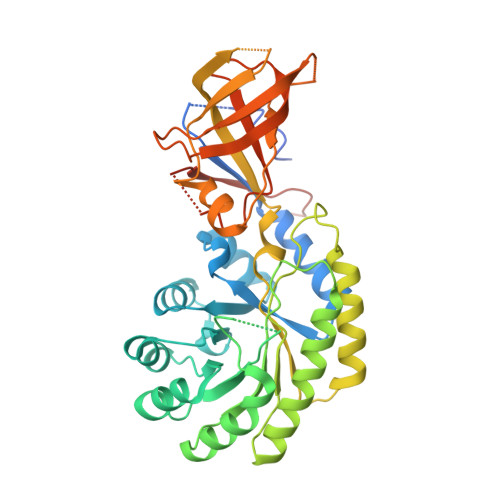X-ray Structure Determination of Trypanosoma brucei Ornithine Decarboxylase Bound to D-Ornithine and to G418: INSIGHTS INTO SUBSTRATE BINDING AND ODC CONFORMATIONAL FLEXIBILITY.
Jackson, L.K., Goldsmith, E.J., Phillips, M.A.(2003) J Biol Chem 278: 22037-22043
- PubMed: 12672797
- DOI: https://doi.org/10.1074/jbc.M300188200
- Primary Citation of Related Structures:
1NJJ - PubMed Abstract:
Ornithine decarboxylase (ODC) is a pyridoxal 5'-phosphate (PLP)-dependent enzyme that catalyzes the rate-determining step in the biosynthesis of polyamines. ODC is a proven drug target to treat African sleeping sickness. The x-ray crystal structure of Trypanosoma brucei ODC in complex with d-ornithine (d-Orn), a substrate analog, and G418 (Geneticin), a weak non-competitive inhibitor, was determined to 2.5-A resolution. d-Orn forms a Schiff base with PLP, and the side chain is in a similar position to that observed for putrescine and alpha-difluoromethylornithine in previous T. brucei ODC structures. The d-Orn carboxylate is positioned on the solvent-exposed side of the active site (si face of PLP), and Gly-199, Gly-362, and His-197 are the only residues within 4.2 A of this moiety. This structure confirms predictions that the carboxylate of d-Orn binds on the si face of PLP, and it supports a model in which the carboxyl group of the substrate l-Orn would be buried on the re face of the cofactor in a pocket that includes Phe-397, Tyr-389, Lys-69 (methylene carbons), and Asp-361. Electron density for G418 was observed at the boundary between the two domains within each ODC monomer. A ten-amino acid loop region (392-401) near the 2-fold axis of the dimer interface, which contributes several residues that form the active site, is disordered in this structure. The disordering of residues in the active site provides a potential mechanism for inhibition by G418 and suggests that allosteric inhibition from this site is feasible.
Organizational Affiliation:
Department of Pharmacology, The University of Texas Southwestern Medical Center, Dallas, 5323 Harry Hines Boulevard, TX 75390-9041, USA.
















